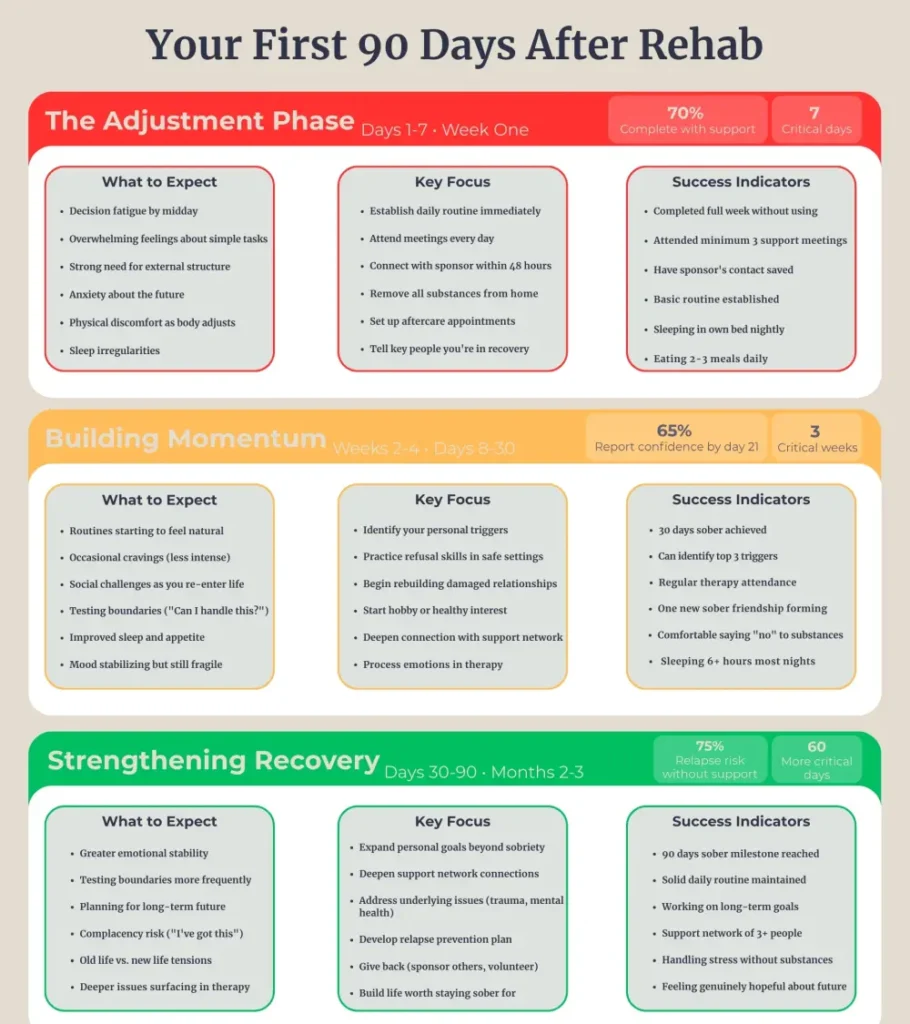We offer medical detox and multiple addiction treatment options in our
luxury treatment centres in Port Hope, Cobourg, and Ottawa.
The 6 Most Important Tips for Life After Rehab
What happens after rehab determines whether your hard work pays off. The first few months test everything you learned. Old triggers resurface. Friends from your using days might reach out. Work stress feels heavier without your old escape route. These moments separate temporary sobriety from lasting recovery.
Recovery doesn't end when you pack your bags and leave the treatment facility. Research shows that structured post-rehab programs and continued support greatly improve long-term outcomes. At the Canadian Centre for Addictions, our 95.6% success rate reflects this reality—recovery thrives when people receive ongoing guidance after addiction treatment ends.
Key Takeaways:
- The first 90 days determine success—learn what to expect when structure disappears and how post-rehab programs fill the gap between treatment and independence.
- Stigma attacks from unexpected places—discover why judgment from healthcare providers and family often hurts more than strangers' opinions, plus three active strategies that actually work.
- Routines prevent relapse better than willpower—find out which daily habits anchor sobriety and why boredom poses a bigger threat than most people realize.
- Mental health can't wait—understand why untreated depression and anxiety sabotage recovery, even when you feel stable months later.
- Your body needs specific repair—explore how exercise and nutrition rewire reward pathways that addiction damaged, making sobriety easier over time.
What Happens After Rehab?
The Reality of Returning Home
Leaving rehab feels strange. The structure disappears overnight. No more scheduled therapy sessions every afternoon. No counsellors checking in three times a day. You're suddenly making all the decisions about how to spend your time and who to spend it with.The brain requires time to adjust. Months or years of substance use rewired neural pathways. After addiction treatment, those pathways start rebuilding, but the process demands patience. Some days bring mental fog. Emotions surge without warning. Sleep comes and goes unpredictably.

Daily life presents unexpected complications. Coworkers ask where you've been. Family members expect immediate change. Your neighbourhood looks the same, even though you've changed. Every familiar place carries memories of your using days.
Bridging the Gap with Support
Post-rehab programs bridge this gap between intensive treatment and independent living. Outpatient therapy offers regular check-ins with a counsellor. Support groups connect you with others facing similar challenges. Sober living homes provide structure without the intensity of residential treatment.
The first week after rehab proves hardest for most people. Simple tasks feel overwhelming. Decision fatigue sets in by midday. This phase passes, though. By week three, routines feel more natural. By month two, you've learned which situations to avoid and which support strategies work best for you.
The Canadian Centre for Addictions designs aftercare plans before clients leave our facilities in Port Hope and Cobourg. These plans map out the first 90 days, identifying potential obstacles and creating specific responses for high-risk situations.

How to Cope with the Stigma of Addiction?
Facing Judgment from Others
People judge. You'll see it in their eyes when they learn about your treatment. Some friends disappear without explanation. Family members tiptoe around the topic at gatherings. Potential employers hesitate when they spot the employment gap on your résumé.
Research published in PMC found that stigma experiences affect every aspect of recovery. Participants reported feeling devalued by treatment staff, healthcare providers, and family members. This rejection often triggered emotional exhaustion that threatened their sobriety.
Different Types of Stigma
Stigma operates on multiple levels. Society holds misconceptions about addiction as a moral failing rather than a medical condition. These attitudes create barriers to housing, employment, and healthcare access. Self-stigma develops when you internalize these negative beliefs, reducing your confidence in maintaining recovery.
Practical Strategies
Active coping strategies help counter the stigma's impact. Education disarms ignorance—when someone makes an uninformed comment, respond with facts about addiction as a brain disorder requiring treatment like any chronic illness. Selective disclosure protects your peace. You don't owe everyone your story. Share details only with people who've earned your trust and demonstrate genuine support.
Build your support network carefully. Connect with others in recovery who understand the challenges without judgment. Their validation counters the stigma you face elsewhere. Practice self-compassion consistently. Addiction doesn't define your worth. Treatment demonstrates strength, not weakness.
The stigma lessens over time as you build evidence of your changed life after recovery. Your actions gradually shift how others perceive you. Focus on what you can control (your recovery efforts) rather than trying to change every negative attitude you encounter.

Tips for a New Start After Addiction Recovery
Recovery requires more than avoiding substances. You're rebuilding an entire lifestyle that supports sobriety while addressing the underlying issues that contributed to your addiction in the first place.
Create a Routine and Stick to It
Structure prevents chaos. During active addiction, days blur together without pattern or purpose. Life after recovery needs predictable rhythms that your brain can rely on.
Wake up at the same time daily. Eat meals on schedule. Set aside specific hours for work, exercise, and relaxation. This consistency reduces decision fatigue and eliminates gaps where old habits creep back in.
Include non-negotiable recovery activities—support group meetings, therapy appointments, and sponsor check-ins. These commitments anchor your sobriety. Boredom threatens recovery, so fill your schedule with meaningful activities. Pick up abandoned hobbies, take classes, volunteer for causes you care about. These experiences rewire your brain's reward system away from substances.
Focus on Your Mental Health
Substance use often masks underlying mental health conditions. Depression, anxiety, trauma, and other disorders frequently co-occur with addiction. After rehab, these issues demand ongoing attention.
Continue therapy even when you feel stable. Sessions help you develop healthier coping mechanisms, process difficult emotions, and identify warning signs before a crisis hits. If prescribed antidepressants or other psychiatric drugs, take them exactly as directed. Never adjust doses without consulting your healthcare provider.
Mindfulness practices strengthen mental resilience. Start with five minutes of meditation each morning. This awareness helps catch negative thinking patterns before they trigger cravings. Sleep directly impacts mental health—aim for seven to nine hours nightly in a cool, dark room. Poor sleep increases irritability, impairs judgment, and weakens your resolve.
Stay Physically Active and Healthy
The body craves repair. Years of substance use took a toll on every system. Exercise accelerates healing while providing natural mood enhancement through endorphin release.
Start small if you've been inactive. A 15-minute walk counts. Gradually increase duration and intensity. Find activities you genuinely enjoy rather than forcing workouts you hate.
Nutrition matters equally. After addiction, your body needs proper fuel to rebuild depleted nutrients. Focus on whole foods—lean proteins, vegetables, fruits, and whole grains. Limit sugar and caffeine, which trigger mood swings and disrupt sleep. Physical activity fills time, connects you with health-focused communities, and proves you can set goals and achieve them.
Set Achievable Goals
Recovery works best when you have clear objectives beyond simply staying sober. Goals give you direction during difficult moments when sobriety alone doesn't feel like enough.
Start with small, concrete targets. "I'll attend three meetings this week." "I'll save $50 from this paycheque." These specific, measurable goals build confidence. Long-term planning comes later—once you've strung together several months, expand your vision. What career moves interest you? Which relationships need mending?
Avoid perfectionism traps. Setbacks happen. A bad day doesn't erase progress. Life after recovery involves learning to handle disappointment without turning to substances. Celebrate wins, no matter how small. Each milestone deserves recognition and reinforces why recovery matters.
Stay Vigilant Against Relapse Triggers
Triggers lurk everywhere after rehab. A song on the radio. The street where you used to buy drugs. Even positive emotions like excitement can spark cravings. Knowing your personal triggers helps you prepare responses before situations become dangerous.
The HALT acronym provides a simple checking system. When cravings hit, ask yourself: Am I Hungry? Angry? Lonely? Tired? These basic needs, when unmet, weaken your defences. Address them immediately.

Create an emergency action plan. Write down three people you can call. List five healthy distractions. Identify safe places you can go if your environment feels threatening. Keep this plan accessible on your phone.
Environmental cues carry powerful associations—the bar where you drank, the friend's house where everyone gets high, and certain times of day. What happens after rehab depends partly on avoiding these situations entirely, especially early on. Warning signs appear before full relapse: skipping meetings, viewing therapy as a chore, reconnecting with using friends "just to say hello." These behaviours signal danger. Reach out immediately.
Leave Old Friends Behind
This tip hurts the most. Some relationships predate your addiction. You have history together, good memories from before substances took over. But if someone in your life actively uses or encourages your use, that relationship threatens your recovery.
Enabling behaviours come in many forms—the friend who says "One drink won't hurt," the family member who makes excuses for your past, the partner who uses you around despite knowing your struggles. These people, however well-meaning, create obstacles to your sobriety. Your recovery must come first.
Building new sober friendships takes time. Support groups provide the easiest starting point. Members understand without judgment. Outside these groups, look for activities that naturally attract sober people—fitness classes, volunteer organizations, educational workshops.
Social pressure situations will arise. Prepare responses in advance. "I'm not drinking tonight" works for casual situations. "I'm in recovery and alcohol isn't an option for me" sets clear boundaries with people who know your history. Post-rehab programs often include social skills training to help you handle these awkward moments through role-playing exercises.
Recovery Continues Beyond These Pages
These six strategies work together to create a strong foundation for life after recovery. Structure provides stability. Mental and physical health give you the energy to face challenges. Clear goals keep you moving forward. Trigger awareness prevents backsliding. Healthy relationships support your efforts.
Recovery remains a daily practice. Some days flow smoothly. Others test every ounce of your resolve. After addiction treatment, you possess tools that weren't available before. Your patterns become clearer. Warning signs stand out. A support network exists where none did previously.
What happens after rehab doesn't have to be a mystery. With proper planning, ongoing support, and commitment to these six principles, you can successfully transition from treatment to a thriving life after recovery.
FAQ
How long does it take to adjust to life after rehab?
Most people need three to six months to feel comfortable with their new routine. The first 30 days present the steepest learning curve as you establish daily habits and test your coping strategies. By month three, routines feel more natural and cravings become less intense.
What are the biggest challenges in the first month after treatment?
Boredom, loneliness, and decision fatigue top the list. Without the structure of treatment, days feel empty. Old friends might pressure you to use. Family expectations can feel overwhelming. Building a solid routine and staying connected to your support network helps tremendously during this vulnerable period.
Do I need to attend support groups forever?
Many people continue attending meetings for years because they find value in the community and accountability. However, frequency typically decreases over time. Early recovery might require daily meetings, while established sobriety might only need weekly or monthly check-ins.
How do I handle cravings when they occur?
Use the HALT method to identify immediate needs (Hungry, Angry, Lonely, Tired). Call someone from your support network. Remove yourself from triggering environments. Engage in a healthy distraction like exercise or a hobby. Cravings typically peak and then subside within 15 to 30 minutes.
What should I do if I relapse?
Reach out for help immediately. Contact your therapist, sponsor, or treatment centre. A relapse doesn't erase your progress, but it does signal that your current approach needs adjustment. The key is getting back on track quickly without shame or self-judgment.
How can family members support someone after rehab?
Learn about addiction and recovery so you can better grasp what your loved one faces. Avoid enabling behaviours like making excuses or providing money without accountability. Attend family therapy sessions when offered. Just as crucial, maintain your own boundaries and seek support for yourself through groups like Al-Anon.





